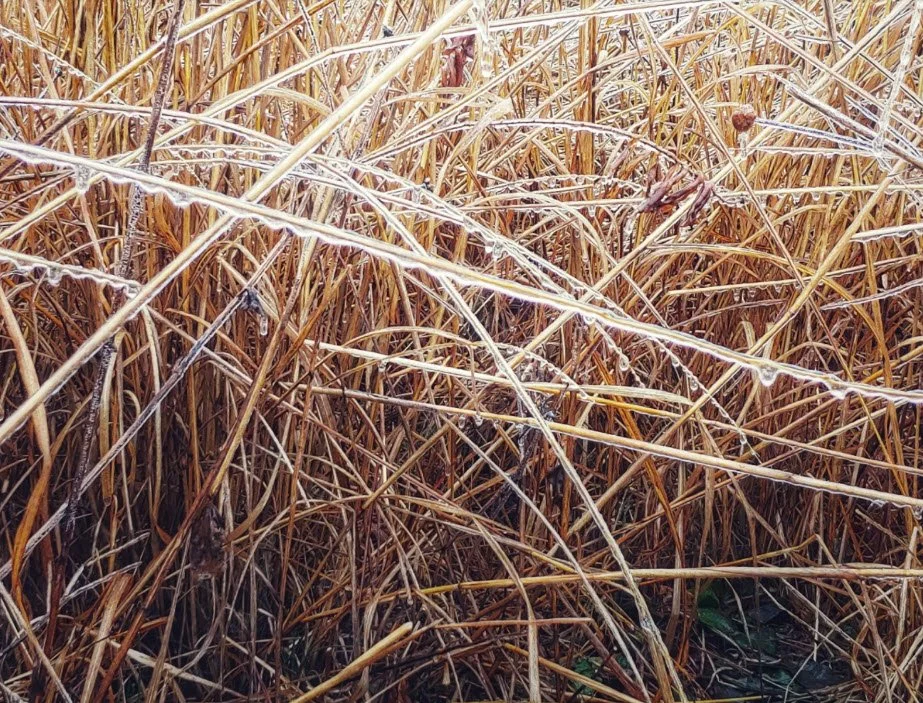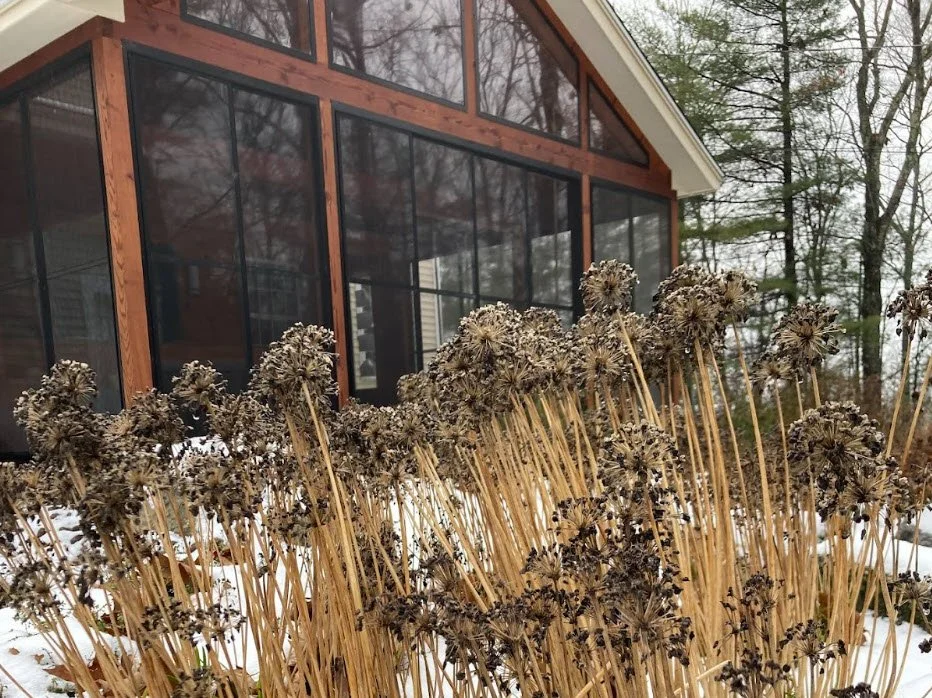A Guide to Ecologically Sound Maintenance Practices
1. Leave a Layer of Leaves in the Garden
In late fall, after the leaves have fallen, leaving a light cover of leaves throughout all garden areas provides an overwintering habitat for beneficial insects. Traditional fall clean-up methods like raking, mowing, and blowing all the leaves out of the garden destroys this habitat opportunity that is essential to the life cycle of many beneficial moths, snails, spiders, and butterflies requiring leaves to overwinter as an egg, caterpillar, or chrysalis. Leaves are not litter! The insects use this leaf cover as protection from predators and cold weather. Many insects like spiders, snails, worms, and beetles overwinter in the leaves, providing a critical food source for birds and other wildlife. Bumble bees also require insulation over the winter from leaf cover, especially the beloved queen bee who burrows several inches beneath the leaves and soil surface.
Overtime, this layer of leaves in the garden will break down, adding organic matter to the soil and helping to build the soil through a natural cycling of nutrients.
While leaving a layer of leaves in the garden is highly beneficial, it’s important to remove any thick, densely matted wet leaves as this can cause growth damage, especially in lawn areas (occasional leaves left on lawn areas can be beneficial, returning nutrients to the soil). A gentle raking or leaf vacuum is recommended rather than a mower or shredder, as this destroys any existing eggs, caterpillars, or chrysalis that might be in the leaves. These leaves can then be collected and removed, or composted on site.
2. A Different Approach to Cutting Back
Rather than shearing all perennials, shrubs, and grasses in the fall, it’s best to leave this beneficial growth throughout the winter and save the cutting for early spring. For similar reasons leaving a layer of leaves is important, leaving the structural growth of perennials, grasses, and shrubs throughout the winter provides optimal habitat for desirable insects and wildlife.
Rudbeckia seed heads and ornamental grasses in late fall
Not only does leaving these structural plants over the winter provide ecological value, they provide a beautiful winter aesthetic to your property! Our compositions take into account the garden’s interest throughout the winter, ensuring a lasting beauty throughout all four seasons.
Allium ‘Summer Beauty’ in winter
Once spring rolls around and it’s time to cut back, it’s recommended to cut herbaceous top growth back to 4-6” high, and in some areas where possible, leaving the stems and only cutting back to 12-18” high. Leaving this taller height in some areas provides essential habitat for stem-nesting native pollinators.
Usually, the plant debris collected from all the cutting is then composted on site. However, if you really want to invest fully in the interest of wildlife and soil quality, this debris can even be left directly on top of the soil at the base of the plants! Some people may view this as “lazy” and “messy”, but the debris can be further cut up as much as desired so as to not be so noticeable from far away, and provides a major benefit to the quality of the soil and the future growth of the plants!
“Narcissus Thalia with emerging perennials living in their own debris. In the spring, we cut back the debris from the previous year and leave it to mulch the current year’s plants. This method requires less work, adds organic matter to the soil and the emerging perennials will quickly cover it.” - Roy Diblik
3. Mulching for a “Green Mulch” Goal
When first establishing a garden, mulching is helpful to prevent weed growth, regulate soil temperature and maintain moisture levels. Just after planting, mulch should be spread about 2” thick, no deeper. If the mulch is applied much thicker than this, the plants will struggle to absorb rainwater, established crowns can become damaged, and the root growth of rhizomatous (spreading) species will become hindered. Nurturing the growth of a well-designed rhizomatic ground layer is the most essential step to achieving our “green mulch” goal.
Recommended mulches
Composted leaf mulch can be obtained from many composting facilities, or produced on site using a leaf shredder or mulching mower. This type is commonly used and does especially well in woodland gardens. Shredded bark mulch (avoiding any dyes) can be more commonly found at retail locations and widely used throughout the garden. Pine needles are another great option for use around acid-loving plants or any plant more sensitive to crown rot. The needles do not mat down, allowing for more air flow around the crown of the plant.
Green Mulch Goal
After initial installation, mulch should then be re-applied as a light layer every spring until the rhizomatic ground layer plants are fully matured. Once the ground layer plantings are fully established and interwoven, mulching is no longer necessary. This ground layer will now act as your sustainable “green mulch” year after year!
River Birch under-planted with an interwoven “green mulch” layer
Carex pensylvanica, perennial Geraniums, and evergreen ground covers
4. Choosing an Alternative Lawn Seed
Choosing an alternative lawn seed can be a great opportunity to go for a more eco-friendly option and reduce overall lawn maintenance. This means less work for you and / or more savings in maintenance costs!
For example, traditional lawn seeds like Kentucky bluegrass or perennial rye require about 1-2” of water per week. For a 1,000 sq. ft. lawn, this means using over 100,000 gallons of water per year! This water usage can be cut down enormously by using an alternative lawn seed mix. Seed mixes that are comprised of more drought tolerant fescues like Sheeps fescue and Creeping red fescues require much less water. For a 1,000 sq. ft. lawn, using a blend of fine fescues would use about a quarter of this amount, requiring around 25,000 gallons of water per year at most.
Using these alternative species for your lawn also eliminates the need for fertilizers and pesticides. Fine fescues like these have such deep root systems that the roots are able to naturally source the nutrients they require from growing deeper into the soil than traditional lawn species. These deep rooted systems also eliminate the need for pesticides, as many insect pests like to live right under the soil surface among the shallow roots of other grass species.
Inspired by knowledge from remarkable plantsmen: Larry Weaner, Kelly Norris, and Roy Diblik


















